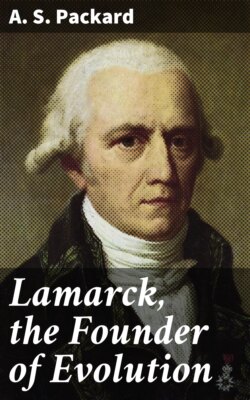Читать книгу Lamarck, the Founder of Evolution - A. S. Packard - Страница 8
На сайте Литреса книга снята с продажи.
FOOTNOTES:
ОглавлениеTable of Contents
[10] Les Grand Naturalists Français au Commencement du XIX Siècle.
[11] Was this quiet place in the region just out of Paris possibly near Mont Valérien? He must have been about twenty-two years old when he met Rousseau and began to study botany seriously. His Flore Française appeared in 1778, when he was thirty-four years old. Rousseau, at the end of his checkered life, from 1770 to 1778, lived in Paris. He often botanized in the suburbs; and Mr. Morley, in his Rousseau, says that “one of his greatest delights was to watch Mont Valérien in the sunset” (p. 436). Rousseau died in Paris in 1778. That Rousseau expressed himself vaguely in favor of evolution is stated by Isidore Geoffroy St. Hilaire, who quotes a “Phrase, malheureusement un peu ambiguë, qui semble montrer, dans se grand écrivain, un partisan de plus de la variabilité du type.” (Résumé des Vues sur l’espèce organique, p. 18, Paris, 1889.) The passage is quoted in Geoffroy’s Histoire Naturelle Générale des Règnes organiques, ii., ch. I., p. 271. I have been unable to verify this quotation.
[12] Leçon d’Ouverture du Cours de l’Évolution des Êtres organisés. Paris, 1888.
[13] Dictionnaire des Termes de la Botanique. Art. Aphrodite.
[14] Discours sur l’Origine et les Fondements de l’Inégalité parmi les Hommes. 1754.
[15] Since 1742, the keeper and demonstrator of the Cabinet, who shared with Thouin, the chief gardener, the care of the Royal Gardens. Daubenton was at that time the leading anatomist of France, and after Buffon’s death he gathered around him all the scientific men who demanded the transformation of the superannuated and incomplete Jardin du Roi, and perhaps initiated the movement which resulted five years later in the creation of the present Museum of Natural History. (Hamy, l. c., p. 12.)
[16] De Mortillet (Lamarck. Par un Groupe de Transformistes, p. 11) states that Lamarck was elected to the Academy at the age of thirty; but as he was born in 1744, and the election took place in 1779, he must have been thirty-five years of age.
[17] Cuvier’s Éloge, p. viii.; also Revue biographique de la Société Malacologique, p. 67.
[18] See letters to the Committee of Public Instruction.
[19] Cuvier’s Éloge, p. viii; also Bourguignat in Revue biog. Soc. Malacologique, p. 67.
[20] He received no remuneration for this service. As was afterwards stated in the National Archives, État des personnes attachées au Muséum National d’Histoire Naturelle a l’époque du messidor an II de la République, he “sent to this establishment seeds of rare plants, interesting minerals, and observations made during his travels in Holland, Germany, and in France. He did not receive any compensation for this service.”
[21] “The illustrious Intendant of the Royal Garden and Cabinet had concentrated in his hands the most varied and extensive powers. Not only did he hold, like his predecessors, the personnel of the establishment entirely at his discretion, but he used the appropriations which were voted to him with a very great independence. Thanks to the universal renown which he had acquired both in science and in literature, Buffon maintained with the men who succeeded one another in office relations which enabled him to do almost anything he liked at the Royal Garden.” His manner to public men, as Condorcet said, was conciliatory and tactful, and to his subordinates he was modest and unpretending. (Professor G. T. Hamy, Les Derniers Jours du Jardin du Roi, etc., p. 3.) Buffon, after nearly fifty years of service as Intendant, died April 16, 1788.
